Climate Change and Cultural Heritage: From Small- to Large-Scale Effects—The Case Study of Nora (Sardinia, Italy)
Abstract
1. Introduction
- (i)
- (ii)
- On a large scale, we can observe the rising sea levels [5].
2. Mining Activity and Extracted Materials in Nora
3. Petrographic and Physical Characterization of Nora Stone Building Materials
4. Materials and Methods
5. Results and Discussion
The Effects of Climate Change on Building Materials
- (i)
- Rainwater acidification due to CO2 atmospheric increase (karst effect) according to [4]:
- (ii)
- Additional rainwater acidification due to atmospheric sulfuric (H2SO4) and nitric acids (HNO3).
- (iii)
- Dry deposition of pollutants SO2 and NOX.
6. The Outcomes of Climate Change on the Archaeological Area
7. Conclusions
Funding
Institutional Review Board Statement
Informed Consent Statement
Data Availability Statement
Conflicts of Interest
References
- Fabio, S.; Massimo, B.; Stefano, C.; Carla, L.; Catarina, M.; José, M. Ancient Restoration and Production Technologies of Roman Mortars from Monuments Placed in Hydrogeological Risk Areas: A Case Study. Archaeol. Anthropol. Sci. 2020, 12, 147. [Google Scholar] [CrossRef]
- Reimann, L.; Vafeidis, A.T.; Brown, S.; Hinkel, J.; Tol, R.S.J. Mediterranean UNESCO World Heritage at Risk from Coastal Flooding and Erosion Due to Sea-Level Rise. Nat. Commun. 2018, 9, 4161. [Google Scholar] [CrossRef]
- Sitzia, F.; Lisci, C.; Mirão, J. The Interaction between Rainwater and Polished Building Stones for Flooring and Cladding—Implications in Architecture. J. Build. Eng. 2022, 52, 104495. [Google Scholar] [CrossRef]
- Spiker, E.C.; Hosker, R.P.; Weintraub, V.C.; Sherwood, S.I. Laboratory Study of SO2 Dry Deposition on Limestone and Marble: Effects of Humidity and Surface Variables. Water Air Soil Pollut. 1995, 85, 2679–2685. [Google Scholar] [CrossRef]
- Sitzia, F.; Peters, M.J.H.; Lisci, C. Climate Change and Its Outcome on the Archaeological Areas and Their Building Materials. The Case Study of Tharros (Italy). Digit. Appl. Archaeol. Cult. Herit. 2022, 25, 1–17. [Google Scholar] [CrossRef]
- Vousdoukas, M.I.; Clarke, J.; Ranasinghe, R.; Reimann, L.; Khalaf, N.; Duong, T.M.; Ouweneel, B.; Sabour, S.; Iles, C.E.; Trisos, C.H.; et al. African Heritage Sites Threatened as Sea-Level Rise Accelerates. Nat. Clim. Chang. 2022, 12, 256–262. [Google Scholar] [CrossRef]
- Pesce, G. Nora, Guida Agli Scavi; Cagliari, Italy, 1972. Available online: https://www.amazon.it/Nora-Guida-agli-scavi-Genanro-Pesce/dp/B009A90X2C (accessed on 15 July 2022).
- Tronchetti, C. Nora; Sassari, Italy, 2001. Available online: http://nora.beniculturali.unipd.it/storia-del-sito/bibliografia-essenziale/ (accessed on 15 July 2021).
- Zucca, R. Tharros; Oristano, Italy, 1993. Available online: https://iris.uniss.it/bitstream/11388/262836/1/Zucca_R_Codex_multiplex_da_Tharros.pdf (accessed on 15 July 2021).
- Macnamara, E. Underwater Exploration of the Ancient Port of Nora, Sardinia. Pap. Br. Sch. Rome 1967, 35, 4–11. [Google Scholar] [CrossRef]
- Di Gregorio, F.; Floris, C.; Matta, P. Ricerche Su Nora I (Anni 1990–1998). In Ricerche Su Nora I (Anni 1990–1998); Soprintendenza Archeologica per le Province di Cagliari e Oristano: Cagliari, Italy, 2000; pp. 9–18. [Google Scholar]
- Bonetto, J.; Falezza, G.; Bertelli, A.; Ebner, D. Nora e Il Mare. Il Progetto Noramar. Attività 2011. In Quaderni Norensi; Padova University Press: Padova, Italy, 2012; pp. 327–338. [Google Scholar]
- Bonetto, J.; Zara, A. The Nora Virtual Tour: An Immersive Visit in the Ancient City. Archeol. e Calc. 2017, 28, 531–538. [Google Scholar]
- Carraro, F.; Marinello, A.; Morabito, D.; Bonetto, J. New Perspectives on the Sanctuary of Aesculapius in Nora (Sardinia): From Photogrammetry to Visualizing and Querying Tools. Open Archaeol. 2019, 5, 263–273. [Google Scholar] [CrossRef]
- Agapiou, A.; Lysandrou, V.; Hadjimitsis, D.G. Earth Observation Contribution to Cultural Heritage Disaster Risk Management: Case Study of Eastern Mediterranean Open Air Archaeological Monuments and Sites. Remote Sens. 2020, 12, 1330. [Google Scholar] [CrossRef]
- Zaina, F.; Cuca, B. Damages to Archaeological Heritage Recorded, Documented and Monitored Using Geospatial Technologies: An Assessement of Indexed Literature. In Proceedings of the IEEE, Mediterranean and Middle-East Geosciences and Remote Sensing Symposium, Istanbul, Turkey, 7–9 March 2022; pp. 110–113. [Google Scholar]
- Deiana, G.; Antonioli, F.; Moretti, L.; Orrù, P.E.; Randazzo, G.; Lo Presti, V. MIS 5.5 Highstand and Future Sea Level Flooding at 2100 and 2300 in Tectonically Stable Areas of Central Mediterranean Sea: Sardinia and the Pontina Plain (Southern Latium), Italy. Water 2021, 13, 2597. [Google Scholar] [CrossRef]
- Sitzia, F.; Lisci, C.; Mirão, J. Accelerate Ageing on Building Stone Materials by Simulating Daily, Seasonal Thermo-Hygrometric Conditions and Solar Radiation of Csa Mediterranean Climate. Constr. Build. Mater. 2020, 266, 121009. [Google Scholar] [CrossRef]
- Sitzia, F.; Lisci, C.; Mirão, J. Building Pathology and Environment: Weathering and Decay of Stone Construction Materials Subjected to a Csa Mediterranean Climate Laboratory Simulation. Constr. Build. Mater. 2021, 300, 124311. [Google Scholar] [CrossRef]
- Massidda, L.; Sanna, U. La Cristallizzazione Salina Nei Materiali Da Costruzione. Enco J. 2001, 14, 8–9. [Google Scholar]
- Massidda, L.; Atzeni, C.; Sanna, U. Acquisizione Di Dati Su Processi Di Degrado e Interventi Di Consolidamento Alle Terme a Mare Di Nora (Pula, CA). Relazione Finale Della Convenzione/Contratto Del 18-07-1994 Stipulata Con La Soprintendenza Archeologica per Le Provincie Di Cagliari Ed Orist. 1994. Available online: https://nora.beniculturali.unipd.it/wp-content/uploads/2015/06/7_Ricerche_su_Nora_1.pdf (accessed on 15 July 2021).
- Assorgia, A.; Barca, S.; Spano, C. Lineamenti Stratigrafici, Tettonici e Magmatici Del Teziario Della Sardegna. In Proceedings of the Convegno Sulla Fossa Sarda; Villanovaforru, Italy, 19–22 June 1997; pp. 13–25. [Google Scholar]
- Beccaluva, L.; Leone, F.; Civetta, L.; Macciotta, G.P.; Ricci, C.A. Geochronology in Sardinia: Results and Problems. Rend. Della Soc. Ital. Di Mineral. E Petrogr. 1985, 40, 57–72. [Google Scholar]
- Carmignani, L.; Oggiano, G.; Funedda, A.; Conti, P.; Pasci, S. The Geological Map of Sardinia (Italy) at 1:250,000 Scale. J. Maps 2015, 12, 826–835. [Google Scholar] [CrossRef]
- Biste, M. Geochemistry of South Sardinian Granites Compared with Their Tin Potential. Met. Assoc. Acid Magmat. 1982, 37, 49. [Google Scholar]
- Zara, A. Evoluzione Urbana e Nuovo Assetto Monumentale Di Nora in Età Medio-Imperiale Romana; University of Padova: Padua, Italy, 2011. [Google Scholar]
- Columbu, S.; Gioncada, A.; Lezzerini, M.; Sitzia, F. Mineralogical-Chemical Alteration and Origin of Ignimbritic Stones Used in the Old Cathedral of Nostra Signora Di Castro (Sardinia, Italy). Stud. Conserv. 2019, 64, 397–422. [Google Scholar] [CrossRef]
- Columbu, S. Petrographic and Geochemical Investigations on the Volcanic Rocks Used in the Punic-Roman Archaeological Site of Nora (Sardinia, Italy). Environ. Earth Sci. 2018, 77, 577. [Google Scholar] [CrossRef]
- Garau, A.M. Le Pietre e Le Malte Del Teatro Di Nora (Sardegna SW); Università degli studi di Cagliari: Cagliari, Italy, 2005. [Google Scholar]
- Finocchi, S. Nora e Il Territorio: Le Risorse Minerarie. In Proceedings of the Nora area C. Scavi 1996–1999; Giannattasio, B.M., Ed.; Genova, Italy, 2003; pp. 31–33. [Google Scholar]
- Previato, C. Nora. Le Cave Di Pietra Della Città Antica; Quasar: Rome, Italy, 2016. [Google Scholar]
- Fadda, A.F. Sardegna, Guida Ai Tesori Nascosti; Coedisar: Cagliari, Italy, 1994. [Google Scholar]
- Billows, E. Lessico Mineralogico per l’Isola Di Sardegna; Ledda: Cagliari, Italy, 1922. [Google Scholar]
- Bechstädt, T.; Boni, M.; Schledding, T. Slope-Sediments in the Cambrian Gonnesa Formation of the Sulcis Area, SW-Sardinia. Neues Jahrb. Für Geol. Und Paläontologie—Mon. 1984, 1984, 129–138. [Google Scholar] [CrossRef]
- Vannelli, V. Guida Al Verde Di Teulada e Del Suo Territorio; Cuec: Cagliari, Italy, 2001. [Google Scholar]
- Palmström, A. RMi-A for Rock Mass Characterization System for Rock Engineering Purposes. Ph.D. Thesis, The University of Oslo, Oslo, Norway, 1995. [Google Scholar]
- Masson-Delmotte, V.; Zhai, P.; Pirani, A.; Connors, S.L.; Péan, C.; Berger, S.; Caud, N.; Chen, Y.; Goldfarb, L.; Gomis, M.I.; et al. IPCC,2021: Climate Change 2021: The Physical Science Basis. In Contribution of Working Group I to the Sixth Assessment Report of the Intergovernmental Panel on Climate Change; 2021. [Google Scholar]
- Peltier, L.C. The Geographic Cycle in Periglacial Regions as It Is Related to Climatic Geomorphology. Ann. Assoc. Am. Geogr. 1950, 40, 214–236. [Google Scholar] [CrossRef]
- Sequeira Braga, M.A.; Paquet, H.; Begonha, A. Weathering of Granites in a Temperate Climate (NW Portugal): Granitic Saprolites and Arenization. Catena 2002, 49, 41–56. [Google Scholar] [CrossRef]
- Sitzia, F.; Beltrame, M.; Lisci, C.; Mirao, J. Micro Destructive Analysis for the Characterization of Ancient Mortars: A Case Study from the Little Roman Bath of Nora (Sardinia, Italy). Heritage 2021, 4, 2544–2562. [Google Scholar] [CrossRef]
- Mustoe, G.E. The Origin of Honeycomb Weathering. Geol. Soc. Am. Bull. 1982, 93, 108. [Google Scholar] [CrossRef]
- Mottershead, D.N.; Pye, K. Tafoni on Coastal Slopes, South Devon, U.K. Earth Surf. Process. Landf. 1994, 19, 543–563. [Google Scholar] [CrossRef]
- Riahi, K.; van Vuuren, D.P.; Kriegler, E.; Edmonds, J.; O’Neill, B.C.; Fujimori, S.; Bauer, N.; Calvin, K.; Dellink, R.; Fricko, O.; et al. The Shared Socioeconomic Pathways and Their Energy, Land Use, and Greenhouse Gas Emissions Implications: An Overview. Glob. Environ. Chang. 2017, 42, 153–168. [Google Scholar] [CrossRef]
- Rogelj, J.; Popp, A.; Calvin, K.V.; Luderer, G.; Emmerling, J.; Gernaat, D.; Fujimori, S.; Strefler, J.; Hasegawa, T.; Marangoni, G.; et al. Scenarios towards Limiting Global Mean Temperature Increase below 1.5 °C. Nat. Clim. Chang. 2018, 8, 325–332. [Google Scholar] [CrossRef]
- Bonazza, A.; Messina, P.; Sabbioni, C.; Grossi, C.M.; Brimblecombe, P. Mapping the Impact of Climate Change on Surface Recession of Carbonate Buildings in Europe. Sci. Total Environ. 2009, 407, 2039–2050. [Google Scholar] [CrossRef]
- Lipfert, F.W. Atmospheric Damage to Calcareous Stones: Comparison and Reconciliation of Recent Experimental Findings. Atmos. Environ. 1989, 23, 415–429. [Google Scholar] [CrossRef]
- Rodhe, H.; Dentener, F.; Schulz, M. The Global Distribution of Acidifying Wet Deposition. Environ. Sci. Technol. 2002, 36, 4382–4388. [Google Scholar] [CrossRef]
- Prentice The Carbon Cycle and Atmospheric Carbon Dioxide; Cambridge University Press: Cambridge, UK, 2001.
- Gregorio, F.D.; Pusceddu, M.; Romoli, E.; Serreli, A.; Carlo, T.; Ambientale, G. Valutazione Del Rischio d’ Erosione Costiera Nell’ Area Archeologica Di Nora (Sardegna SW). In Proceedings of the Atti 14a Conferenza Nazionale ASITA, Brescia, Italy, 9–12 November 2010; pp. 869–874. [Google Scholar]
- Di Gregorio, F.; Floris, C.; Matta, P.; Roppa, A. Il Quadro Am- Bientale, in Nora. Il Foro Romano. Storia Di UN’AREA Urbana DALL’ETÀ Fenicia Alla Tarda Antichità; Italgraf (Noventa Padovana): Padova, Italy, 2009. [Google Scholar]
- Lambeck, K.; Purcell, A. Sea-Level Change in the Mediterranean Sea since the LGM: Model Predictions for Tectonically Stable Areas. Quat. Sci. Rev. 2005, 24, 1969–1988. [Google Scholar] [CrossRef]

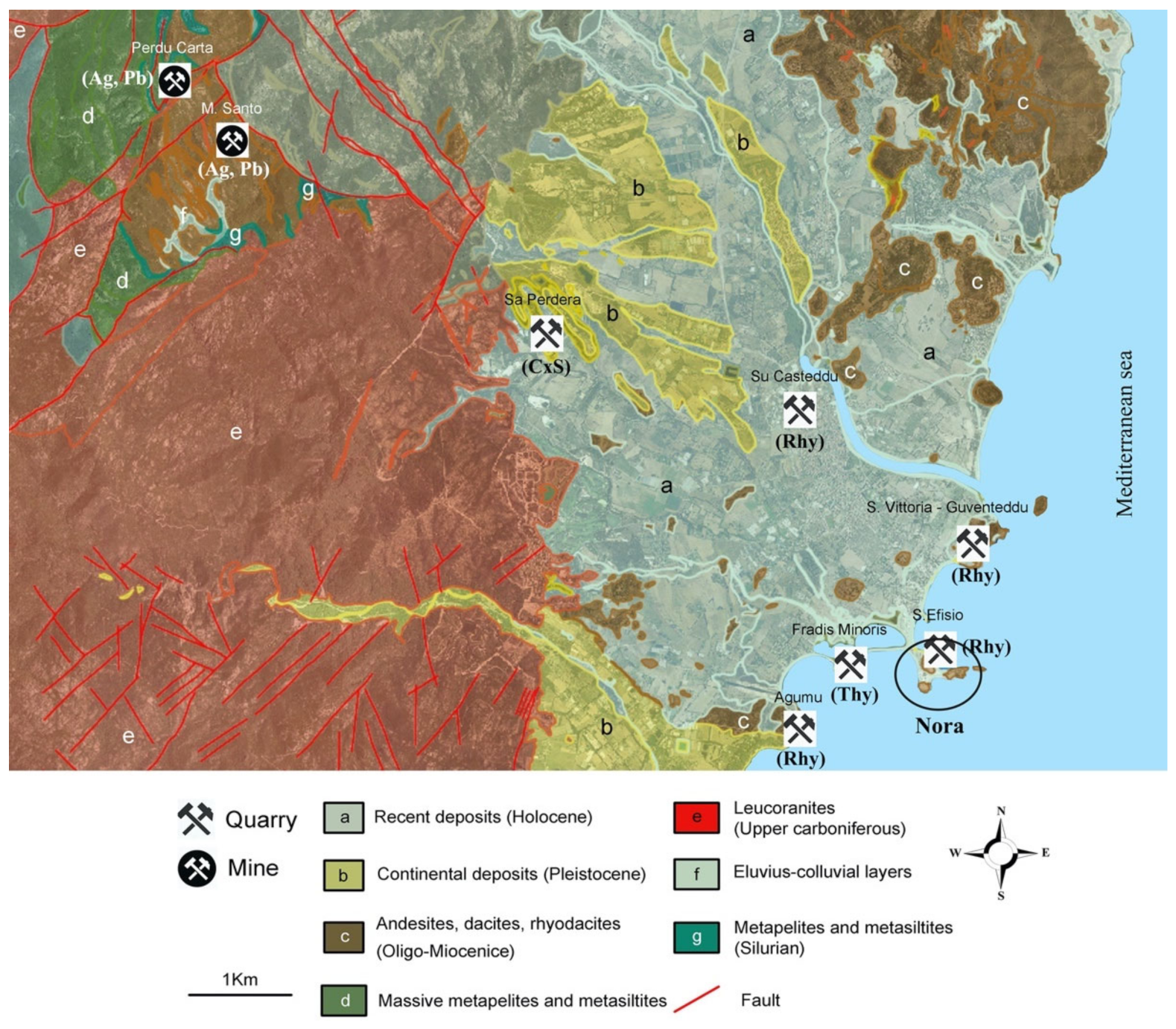
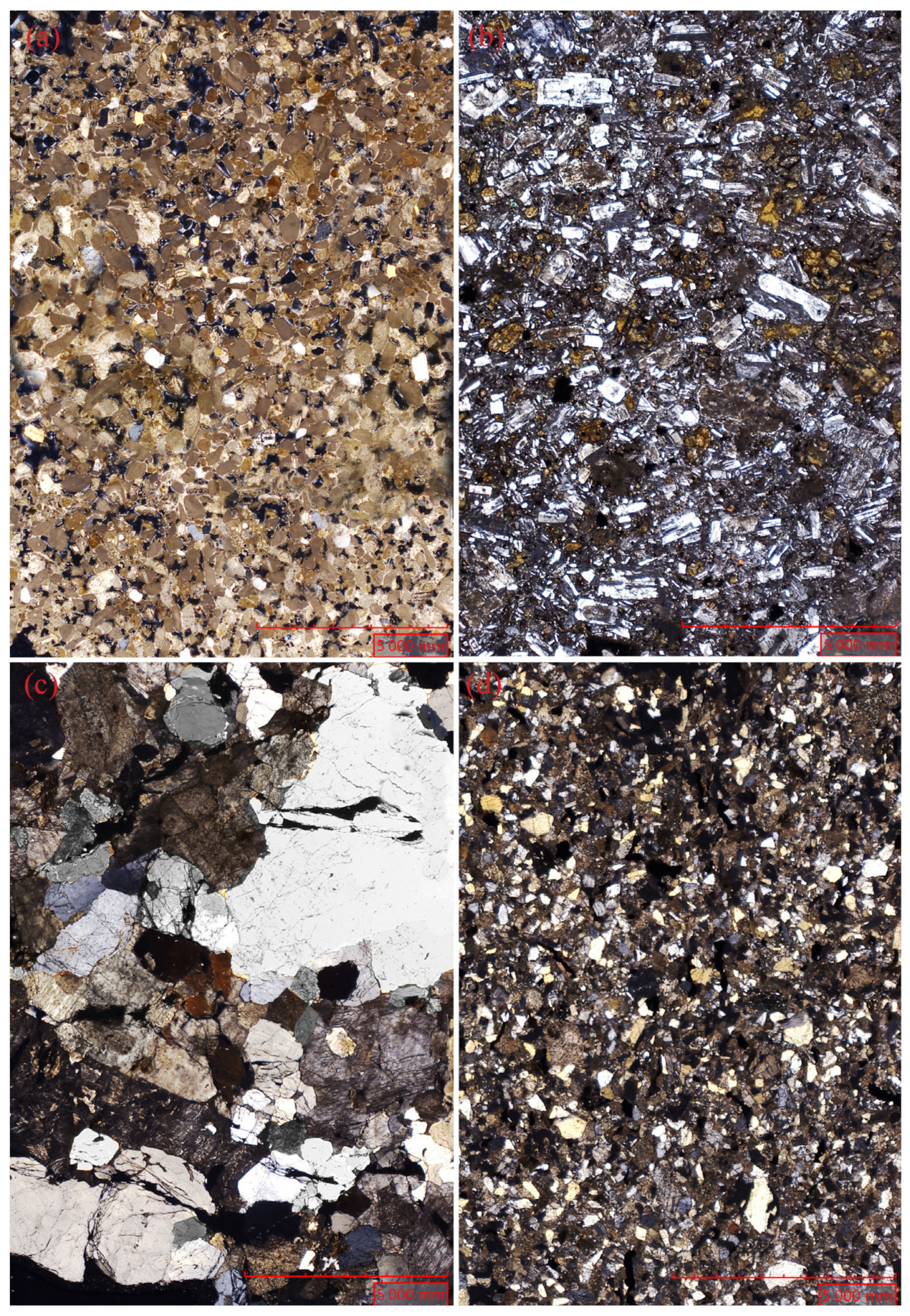
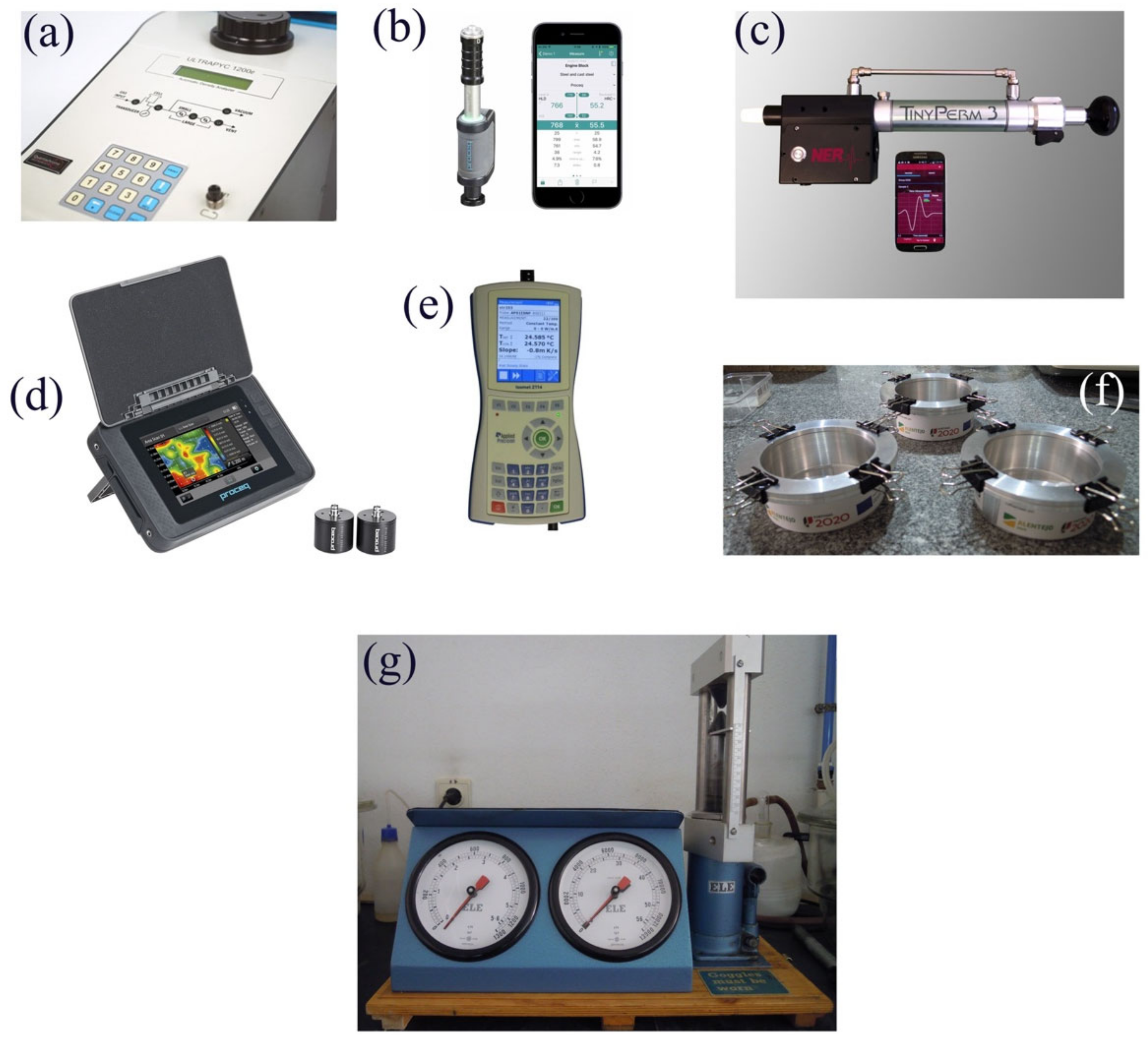
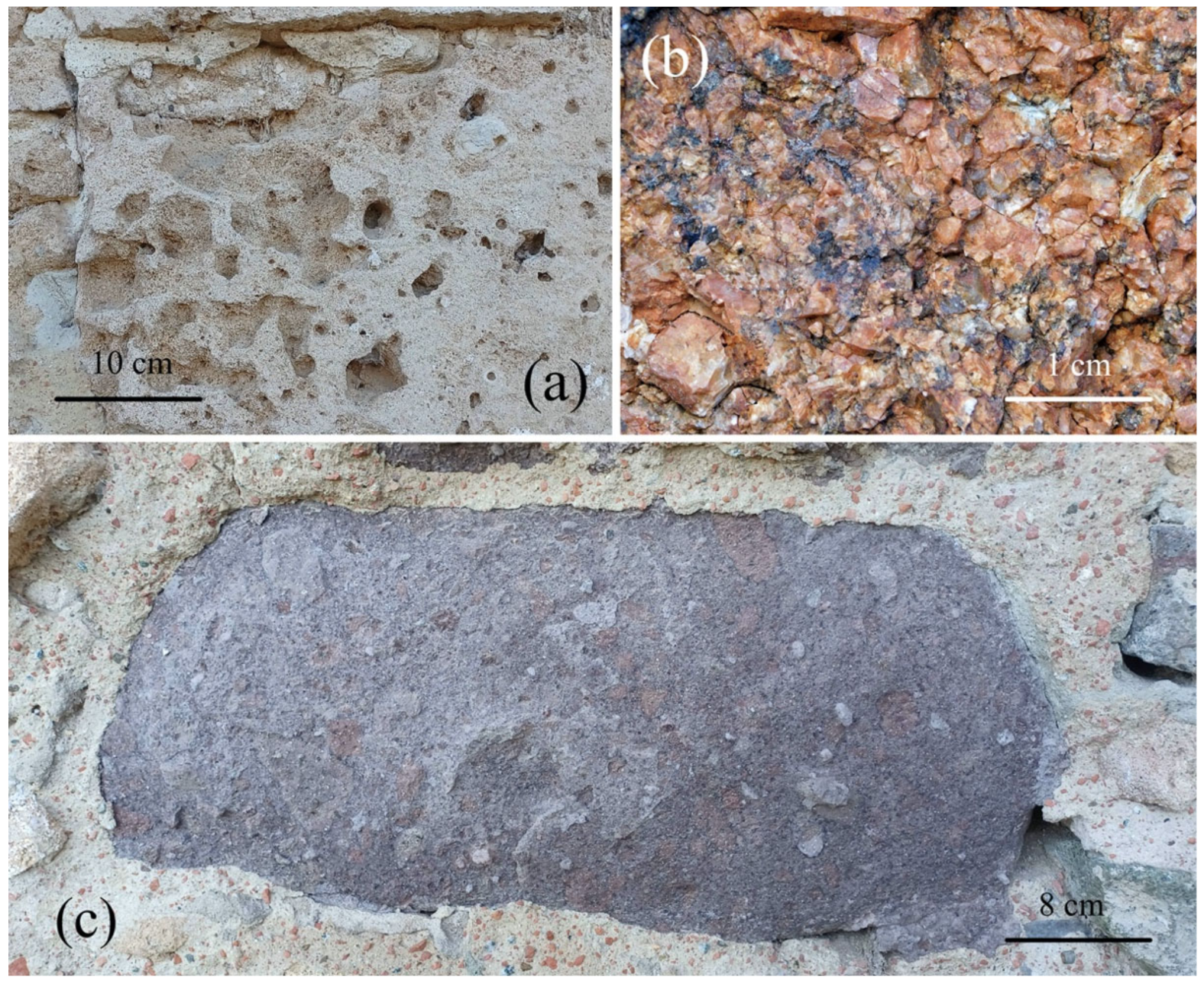

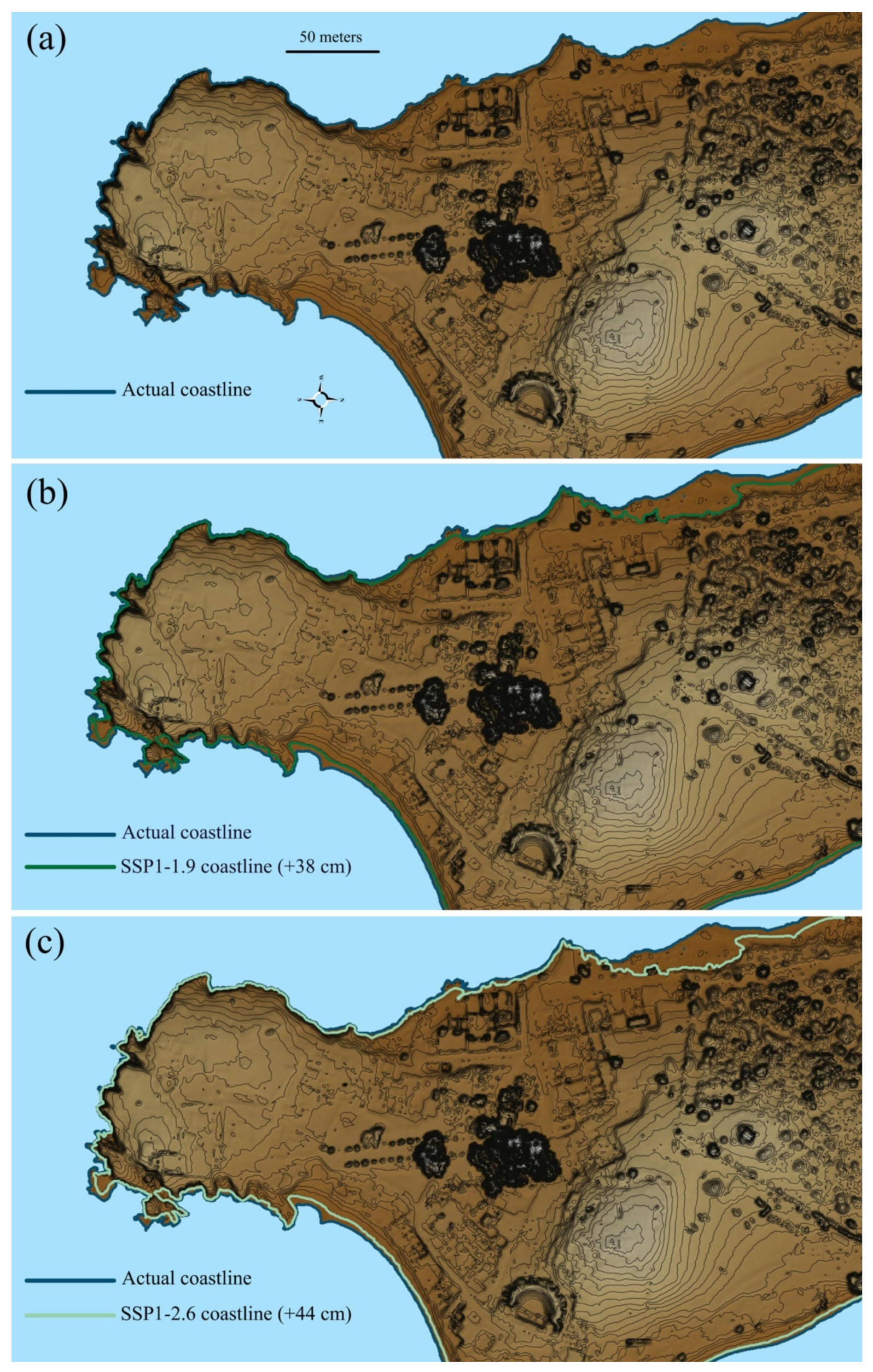
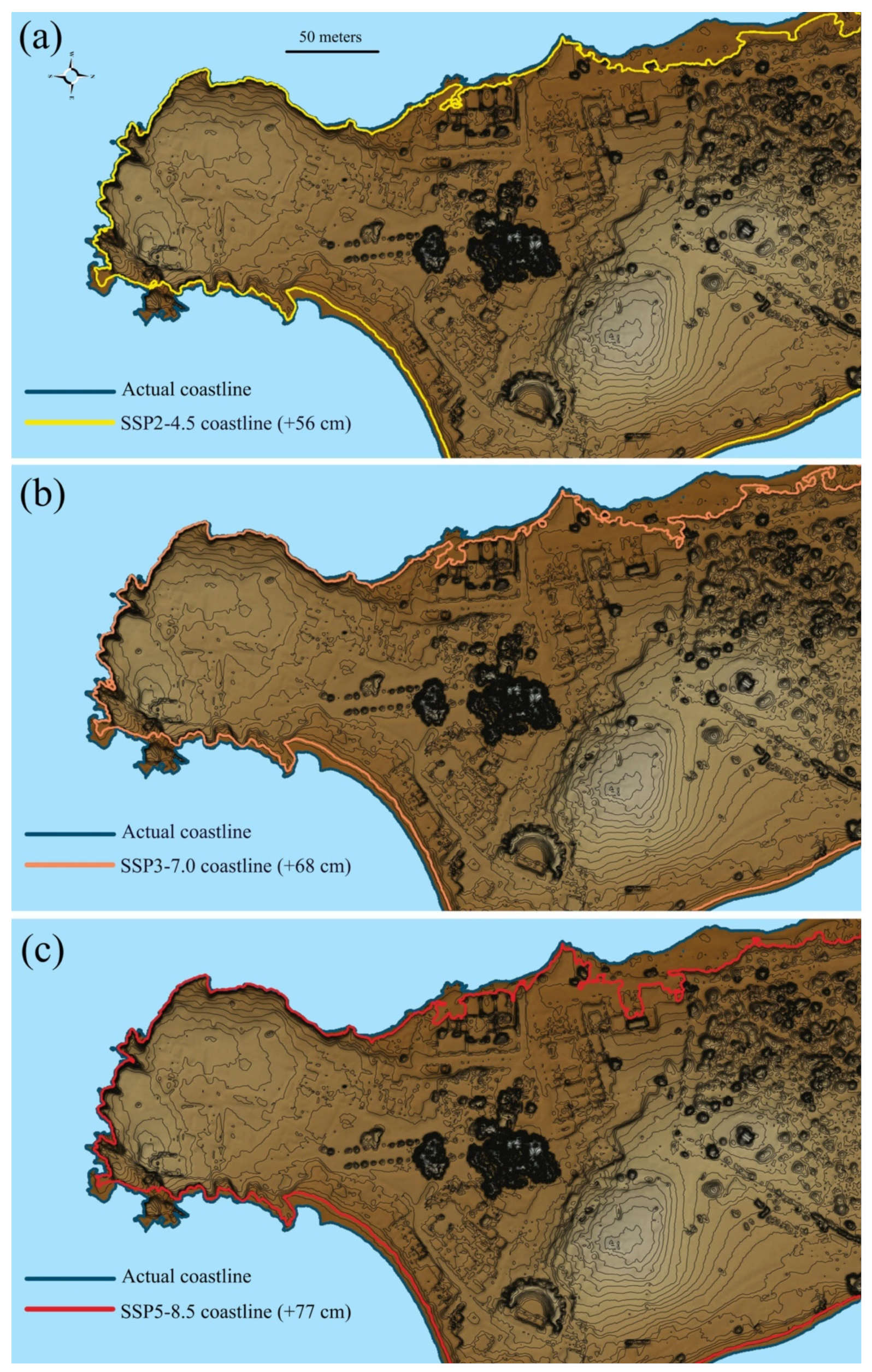
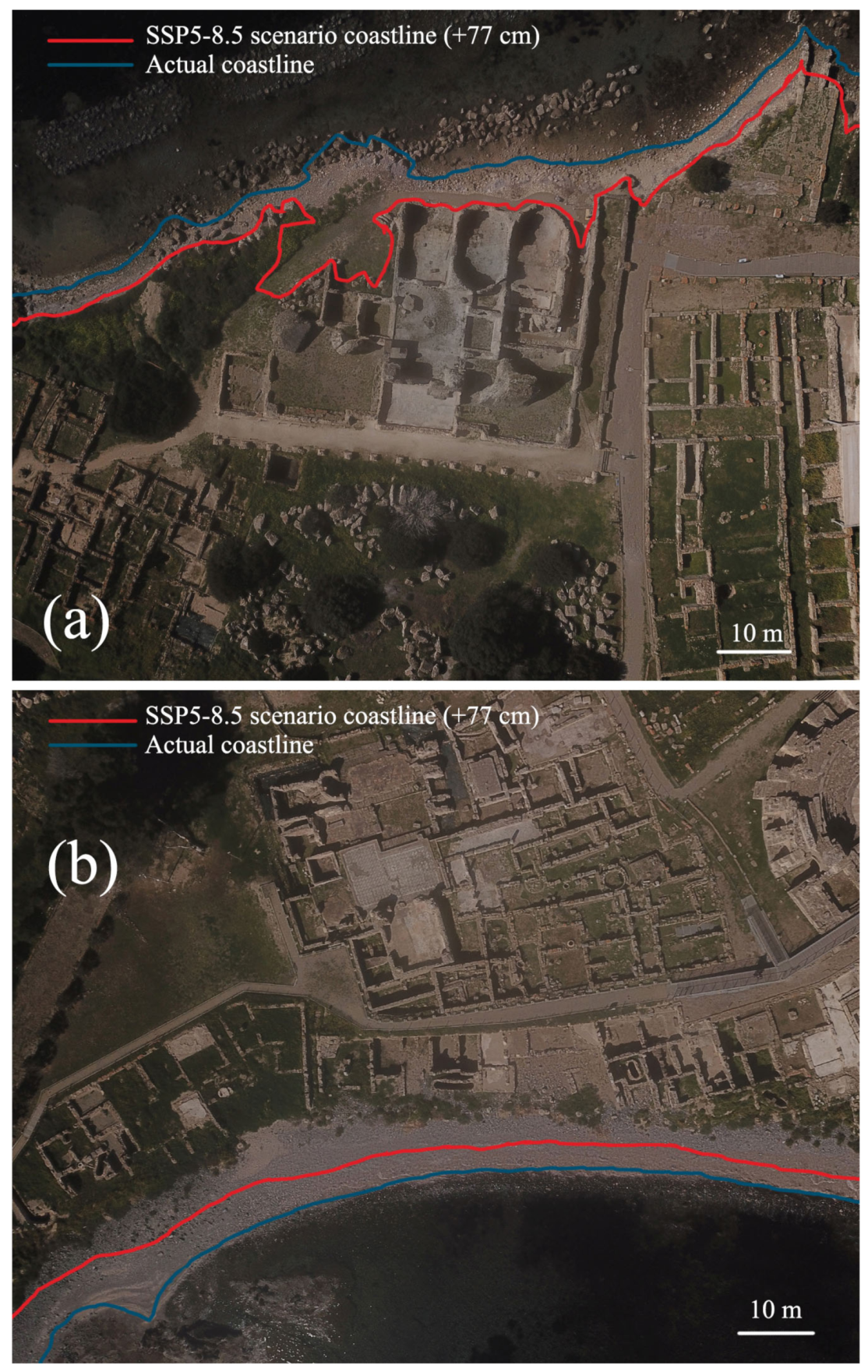
| Physical–Mechanical Properties | Stone Building Materials in Nora Site | |||
|---|---|---|---|---|
| Granite | Rhyodacite | Thyrrenian Sandstone | Cixerri Sandstone | |
| Bulk density (ρB, g/cm3) [5] | 2.61 ± 0.04 | 1.65 ± 0.06 | 1.65 ± 0.08 | 1.84 ± 0.05 |
| Efficacy porosity (ΦO, %) [5] | 7 ± 3.9 | 23 ± 1.9 | 38 ± 3.8 | 29 ± 1.6 |
| Closed porosity (ΦC, %) [5] | 1.7 ± 0.9 | 2.1 ± 0.9 | 3.8 ± 0.5 | 4.5 ± 0.4 |
| Saturation index (S.I., %) [5] | 88 ± 7.2 | 94 ± 6.4 | 86 ± 3.7 | 81 ± 5 |
| Total immersion coefficient (CIW, %) [5] | 3 ± 1.7 | 11 ± 6.4 | 20 ± 2.9 | 7 ± 3.1 |
| Weight lost on immersion (WDC, g/g) [5] | 0.0047 ± 0.015 | 0 | 0.022 ± 0.01 | 0.01 ± 0.002 |
| Point load strength index (Is50, MPa) [5] | 1.64 ± 0.2 | 7 ± 2.9 | 0.7 ± 0.3 | 0.5 ± 0.3 |
| Compressive strength (σC, MPa) [5] | 23 ± 2.6 | 143 ± 58.3 | 10 ± 4.1 | 7 ± 4.7 |
| Thermal conductivity (k, W/m⋅K) [3] | 2.99 ± 0.28 | 1.09 ± 0.10 | 1.21 ± 0.32 | 1.43 ± 0.15 |
| Volume heat capacity (s, J/m3⋅K) [3] | 1.31× 106 ± 3.3 × 104 | 1.88 × 106 ± 4.7 × 104 | 1.66 × 106 ± 2.7 × 104 | 1.55 × 106 ± 3.9 × 104 |
| Thermal diffusivity (α, m2/s) [3] | 2.27 × 10−6 ± 2.25 × 10−8 | 0.59 × 10−6 ± 4.84 × 10−8 | 0.72 × 10−6 ± 1.54 × 10−7 | 0.92 × 10−6 ± 7.25 × 10−8 |
| Leeb D hardness (LH, HLD) [6] | 570 ± 97 | 675 ± 18 | 445 ± 68 | 350 ± 29 |
| Vapor permeability (kV, g/m⋅s⋅Pa) [1] | 1.5 × 10−11 | 2.6 × 10−11 | 3.5 × 10−11 | 1.8 × 10−11 |
| Gas driven permeability (kG, mDarcy) [6] | 5.4 ± 5 | N/A | 3350 ± 1000 | 43 ± 22 |
| P wave speed (VP, m/s) [3] | 2410 ± 71 | 3906 ± 71 | 2326 ± 117 | 1905 ± 81 |
| S wave speed (VS, m/s) [3] | 1268 ± 56 | 1914 ± 31 | 1192 ± 20 | 1075 ± 11 |
| Stone Materials | Ca | Qz | Pla | Kf | Bio | Gy | Kao | Mu | Zeo | Ver |
|---|---|---|---|---|---|---|---|---|---|---|
| Leucogranite | - | ••• | •• | • | Tr | - | Tr | - | - | - |
| Thyrrenian sandstone | ••• | •• | • | - | - | Tr | - | Tr | - | - |
| Cixerri Sandstone | •• | ••• | • | •• | • | - | - | - | - | Tr |
| Rhyodacite | - | • | ••• | - | - | Tr | - | - | • | - |
| Year 2100 A.D. Scenario | Average Sea Level Change (cm) | Coastline Shifting Max (m) | Submerged Area (Hectares) | Submerged Surface (%) |
|---|---|---|---|---|
| SSP1-1.9 | 38 | 23.7 | 7.34 | 3.54 |
| SSP1-2.6 | 44 | 23.9 | 7.2 | 5.39 |
| SSP2-4.5 | 56 | 24.1 | 7.13 | 6.35 |
| SSP3-7.0 | 68 | 26.2 | 7.01 | 7.92 |
| SSP5-8.5 | 77 | 28.5 | 6.95 | 8.69 |
Publisher’s Note: MDPI stays neutral with regard to jurisdictional claims in published maps and institutional affiliations. |
© 2022 by the author. Licensee MDPI, Basel, Switzerland. This article is an open access article distributed under the terms and conditions of the Creative Commons Attribution (CC BY) license (https://creativecommons.org/licenses/by/4.0/).
Share and Cite
Sitzia, F. Climate Change and Cultural Heritage: From Small- to Large-Scale Effects—The Case Study of Nora (Sardinia, Italy). Heritage 2022, 5, 3495-3514. https://doi.org/10.3390/heritage5040181
Sitzia F. Climate Change and Cultural Heritage: From Small- to Large-Scale Effects—The Case Study of Nora (Sardinia, Italy). Heritage. 2022; 5(4):3495-3514. https://doi.org/10.3390/heritage5040181
Chicago/Turabian StyleSitzia, Fabio. 2022. "Climate Change and Cultural Heritage: From Small- to Large-Scale Effects—The Case Study of Nora (Sardinia, Italy)" Heritage 5, no. 4: 3495-3514. https://doi.org/10.3390/heritage5040181
APA StyleSitzia, F. (2022). Climate Change and Cultural Heritage: From Small- to Large-Scale Effects—The Case Study of Nora (Sardinia, Italy). Heritage, 5(4), 3495-3514. https://doi.org/10.3390/heritage5040181







